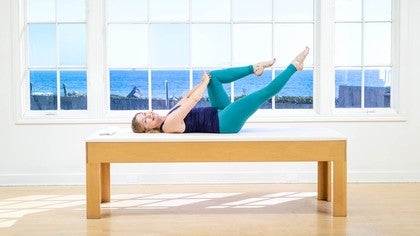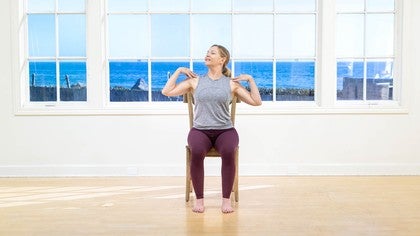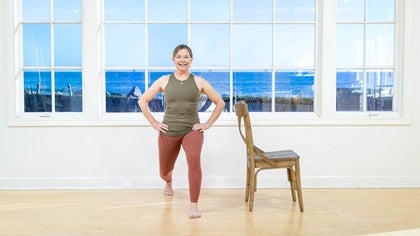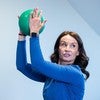Description
About This Video
Transcript
Read Full Transcript
Hi, my name is Amy Havens. I'm here with Pilates Anytime to teach the first of a four class series, Pilates series. Today's class is strong spine and core stability, and all you're going to need is a hand towel, folded up this way. Be sure to consult your doctor before starting any new exercise regime. We're gonna go ahead and get started.
I'd like everyone to start standing. We're gonna brush just really quickly through what does it mean to have a strong spine and a strong core. And core is inclusive of lots of things in the body. But for this class, in this intention, we're gonna a focus on the muscles in the abdomen, the front, and the side, and the lower back, and also through your hips, okay? Everyone has their own spine shape and curves, but we all have the same three curves of our spine.
We have a cervical curve, which is in our neck. We have a thoracic curve, we can think through the rib cage. And we have a lumbar curve which is in the lower back. And everybody's spines are a little bit different, but we do all have those same curves. All right, so I want everybody, just put your hand, one hand behind your neck curve, that's your cervical curve, and then the other one in your low back curve.
So you can just go and put them here. Notice that those two curves kind of curve in, into your body, right? Now the other curve, your rib cage curve, your thoracic curve, that part of our back actually comes back just a little bit. It's not excessive but we've got this kind of inward, outward, inward shape through the spine, and that's meant to be there for shock absorption. We're not meant to have a straight up and down spine, okay?
So those curves are meant to be there for natural resiliency and longevity of the joints of the spine and through the whole body. So when we talk about core strength, we don't wanna diminish those curves. We wanna keep them long, I like to think of decompression through those joints of the spine, long and strong. You're gonna hear me say that a lot, length with strength or long and strong, okay? So knowing we've got those three curves, I want you to just stand as you are like I am, parallel with your legs and whatever it means for you to be tall.
For me, I like to think about my abdominals being long, my shoulders open and just that sense that my neck is also quite long, okay? Let's just start with a nice deep breath in through the nose. (inhales deeply) So in this work today, when we exhale, I'm gonna ask us to really feel effort in the tummy, I'll just call it the tummy or the abs. So put one hand on your stomach, okay? And then put the other hand, remember we talked about that in the lumbar curve, put it here.
So you got one in front of the other. And as we take a breath in, let's be long between these two points. (inhales deeply) And as we exhale, feel your stomach muscles come in away from this hand, press a little bit. Let's do that again. Take a breath in through your nose.
(inhales deeply) And as we exhale, the endeavor is to contract but not shorten and not kind of like crunch this way through the core of the body instead stay tall through that part. Let's try it again. Nice deep breath in. (inhales deeply) And then as you exhale again, feeling the contraction of the abdominals, feel the contraction of your back muscles. Couple more.
(inhales deeply) Length and strength, exhale. Feel yourself, pull your stomach in away from this hand, your back nice and working, you're nice and solid. One more time, everybody. (inhales deeply) And exhale. (exhales slowly) You don't have to make noise, but that's what I like to do.
I'd like to like, (exhales loudly) really squeeze the air out. Okay, and then relax your hands. So hopefully you feel a little bit of effort already just in this part of your body. We're gonna do something to, before we get down on the mat. And I love to have us think about mobilizing before stabilizing.
And then we're gonna do a little bit of that here too. And I think a strong core and a strong spine includes movements that are natural, natural function every day and that we wanna move our spine in every way every day, not just one habitual pattern or position, okay? So, everybody, just reach your arms out all the way up, you can think about reaching for the stars for a moment. We're gonna do something called a standing roll down. This is really just to start some awareness too, you can just drop your hands.
And let your cervical spine round forward, I'll do it from the side here then your thoracic spine where your rib cage is, and then just round all the way down so that your low back is in somewhat of a curve. You may or may not have your hands touch the floor. You may or may not have your knees straight, it's okay if they're a little bit bent. What I want you to recognize is that you've rounded forward and you've mobilized down to this position. Now we're gonna mobilize to go back up and it starts at the lower back.
It's kind of like a bicycle chain, one link on a chain at a time until you arrive all the way back through that cervical spine where we started. Let's do one more. Take a deep breath, okay? And yeah, it's around of the head and the neck, the cervical spine moving mobilizing through the thoracic spine. You may notice some places have more mobility on your spine than others.
This is all for you to feel your way through here, take a deep breath. You can bend your knees or keep them straight and roll yourself back up. Okay, mobilizing the spines. We're gonna go on down to the mat, everybody. I happen to have this wonderful big mat, you're on your mat at home and just lie flat.
So here we go. Have that towel nearby, in fact, you can just go ahead and put it like this underneath your neck for just there. We'll probably use that for something. So if you put your hands on your pelvis right there, these two bumpy bones on the front of your pelvis here, we're gonna refer to this area. And I want everybody just real quick to put one hand underneath the lower back of yourself.
That's your lumbar curve, remember, keep that for a moment. I want you to take a breath. (inhales deeply) As we exhale, now, flatten that curve by tipping your hips back, hips are going back that way and feel the abdominal muscles really pull inward together. Almost like your hips are getting closer together too, okay? Feel that, feel that work in your abdominal wall.
And then release that until your pelvis is nice and flat. Couple more of those. We're just gonna rock the pelvis. Exhale, rock the pelvis back. Your whole back should feel flat, should feel good.
Tummy firm, inhale, and rock to neutral or level pelvis. One more time, exhale. (exhales slowly) So I want you to stay here. Some of you may already start to be feeling other muscles kinda naturally coming to work here in the back of the hips, the back of the legs, all very natural. Let it all happen, okay?
And then come back to neutral. Remember the core of the body is not just here, it's inclusive of hips and your spine muscles as well. We're gonna add on to that, move a little more, take a breath. Same thing coming through the pelvis to your lower back. Now, I want you, everybody, come halfway up your back.
What does that mean, Amy? What's halfway up your back? It's about the base of your rib cage is what I want you to think about there, the bottom of your ribs. And then return mobilizing the spine all the way down to level. Twice more, deep breath.
(inhales deeply) Exhale. (exhales slowly) Roll, there goes that flat back. And now you're mobilizing up the spine just a little bit further. Inhale here, and exhale, come back down, okay? One more like that, everybody, inhale and exhale.
If the abdominals that contract in, the pelvis tips, you will start to mobilize up your back. Now, how about going higher? Some of you are gonna want to, let's go. You're gonna come all the way, I'm going up between my shoulder blades now. Notice what other muscles you might be feeling in your legs, possibly your buttocks, back of your thighs, back of your arms, all parts of your body.
Here we go, mobilize all the way down. Here we go. We'll do twice more, inhaling. Very common Pilates exercise is the pelvic curl. Really nice way to get into the muscles of the legs, the abdominals, and the back, and rolling down.
So like I said, we do a lot of mobilization before we do stability work. The stability work, in my opinion, is where the deep, deep, deep abdominal muscles start to get called on. And we put the body in different load factors. Okay, yeah, and that's how we start to really build this internal core strength. But before we do, I want you to turn your knees to one side, I'm gonna face you, everybody, interlace the hands behind your head.
And then just easy, easy, lift that elbow and turn your chest toward the ceiling. I want you to get some mobility through this chest part of your spine. I like to call it the chest spine, easy to remember, thoracic spine. We wanna mobilize through here, this is a place where some of us can get really sticky. If you don't move this part of your body very often, okay?
It is part of your core. Absolutely, your back is right there. One more time, okay? And then all the way around, you're gonna do the other side as well so you're gonna see me just turn away from you barely briefly. Okay, and your elbows resting, you're turning your chest toward the ceiling.
Open that chest wall, take a breath, and close. Remember this is some mobility work. Mobilizing, opening up, getting ready for deeper exercises that you'll feel your tummy and your body more so. One more, everybody. Yeah, inhale, exhale.
Okay, we're gonna continue rolling right back on your back. Conveniently, your hands are right here by your towel. Pick your towel up at your hands. Okay, so we've warmed up the lower spine and the middle spine. We're gonna work on the neck part of the spine, that cervical.
I like to do it with support And we're not doing many of these. So you have your towel right behind your skull, lift your elbows up off the floor a little bit, you should see them out of the corners of your eyes. We're gonna do a lift of the head and a bend of the neck forward. Think of it, this is mobilizing your neck and your upper back, everybody. But you will feel your tummy, you're gonna feel your abdominal muscles roll and mobilize that back down.
Breathe in first, please. And everybody exhale. (exhales slowly) Lift that head, mobilize, feel the stretch in your upper back, okay? So it's common in Pilates classes, in exercise like this class to have your head up. I'm not gonna have the head up though for many of the next coming exercises.
You can choose to, but I'm gonna leave mine down. And I'd like to invite you to keep yours down because I think you'll get more out of the core work. Here we go, last one. But in attempt to mobilize the spine, we've included that cervical flexion and thoracic flexion. Okay, now we're gonna build onto this.
Put your hands, everybody, right here at the base of your rib cage, okay? So pretty famous little rib here known as the 12th rib. Sometimes it's referred to as a floating rib. It doesn't float, but often it doesn't sit down on the mat as easily, it kind of rests up, that's part of that natural curve that we have. But in this next series of exercises, I want us all to really feel effort from the front to get this part of the rib cage down, okay?
And you should feel this really strong band of muscle work right here around your rib cage. So take your breath. I'm gonna keep my hands here as reference. We're gonna start moving a leg, exhale, one leg, just bring a leg to a chest. Just bring your leg to your chest.
Contract your abs to do that, inhale, lower the leg. Alternate sides, it comes from here first. (exhales slowly) Inhale, lower down, okay? So it's small beginning, exhale from the tummy, feel your back to go down. From the core of the body, the inside, the center of the body, and then the outside, things move like the limbs.
One more. Start here. (exhales slowly) Bend the leg. It's important to move consciously with control. Now I want you to keep this leg up, take another breath.
Add the second leg. (exhales slowly) Okay, so let's park the legs here for a moment. I want you all really, really zone in on concentration right now. This is the key, this is the 12th rib. I don't want anybody's 12th rib to lift up off the mat, that's the destabilizing moment, we're here to stabilize and build a strong center, okay?
So that's your job, is to keep that down on the table. So here what I'm gonna do is this kinda, I call it pistons, and just move the legs back and forth. There's no rule, right way to do this other than keeping your back down. So if that's too much for you, you might be moving like this. If it's too easy, you can go this way.
Go for it, touch the toes to the floor. Feel your stomach root down into your back. Let's take it for eight, and seven, whoo, six, five, four, three, two, and one, you know how to count. And then everybody put both feet down, okay? So I think you're probably starting to feel a little bit of work here to stabilize, building some strength through this whole part.
Adding on, take a breath, stabilize, lift a leg, (exhales slowly) Lift the second leg, okay, it's about to get more intense. I want you to flex your feet, put your hands in the front of your thighs. Now the objective here, keep sinking that 12th rib, take a breath. I want you to press your knees into your hands, flatten your back even more and push your hands against your knees. And just really feel this band of effort in your middle, okay?
And then release for a second. Four of them total, that's all we need. Inhale first. Let's press and hold for a three count. Hold, two, three, and release.
Once you think about your shoulders for one second, low off your ears, okay? We've got two more of these isometric abdominal exercises. Take a breath. Here we go, exhale, knees press in, hold for one, your back is flat, two, three, and soft and release. Once more, inhale, let's go for it, guys.
Exhale, press the knees to hands, one, press a little more, two, press a little more, three. Now hold the feeling and try to let go and just hold the feeling. Hold the feeling, go back to those pistons. Hold the feeling, let's go four, three, two, one, and relax for a minute, okay? Adding on, take a breath.
One knee up. (exhales slowly) Second knee up. Okay, instead of both hands on both knees or one on each, put both on one, that leg continues to press in. And I want you to take the other leg up. Ideally, a straight knee, doesn't matter to me if it's bent, you're gonna start to lower this leg while you stabilize.
Okay, very important, that 12th rib has to stay on the floor, here we go. (inhales deeply) (exhales slowly) So I'm pressing the other knee into my hand, relaxing the foot. This is up to you, how low do you take your leg, maintaining that stability in the center. Feel how strong we're getting, right? And then bring it back in.
I only wanted to do three of those, it's pretty intense. Take it up, number two. Press the other knee to your hands. Lower that leg. You're thinking stomach to spine, spine to stomach, 12th rib on the floor, shoulders off the ears, and coming in.
Once more an (exhales slowly). Objective, right? We're loading the body, this long leg out there. (laughs) Mine's not that long, but the long leg. How long can you hold it there?
It's so much challenge for the center of the body. Yeah, and then in, okay? We have the other side three times. Hands in front of the knee, leg up. Breathe in, blow, go.
(exhales slowly) Take it down. I'm moving slowly so we can concentrate on the stability. The strength you're building, moving slow and consciously and return. Second round, inhale, exhale, press the knee. That's providing the stability of the pelvis and the spine.
You're lowering this lever, we call it, leaver arm or leaver leg. Just challenging the muscles of the core or your spine technically and its stability. Here we go. (exhales slowly) Last one, 12th rib, 12th rib, 12th rib, and then everybody come in and rest. Okay, let's place the feet down and just rest for a second.
I think you're starting to feel, I hope, starting to feel what's happening in the middle of the body. Let's go onto our side now, everybody. I'm gonna roll into my side facing you. We don't need the towel. But you can bend your elbow and just set your head on your arm.
Take your legs very straight in line with your pelvis. And let's flashback to the very beginning of class when we were talking about the three curves, our low back curve, our middle back curve, and our neck curve. We're trying to have those in kind of a harmonious line right now, right? So you're not thrusting your tailbone under, shortening your abdominals, that length with strength feeling here, okay? Really important.
Now, 12th rib isn't touching anything because there's nothing behind us but I want you to pretend as if it is if you know what I mean. Or you can even put your hand behind you. That would be the way to test that, okay? Now, if you don't want to, you can put your hand here or for some of you, I'll show you a variation in just a second. Let's roll that shoulder down.
Breathe in, we're gonna pick up our legs, but we're picking it up because we've contract here first, exhale, pull the abdominals to the spine, the spine to the abdominals and look what happens down there, the legs lift, hold it. Keep breathing and holding. You're gonna feel a lot of work around your abdomen, your waist, your back. Remember I said, that's part of our core muscles, okay? And lower.
Let's do it again there. Inhale, and exhale, lift those legs. Stretch your body long, long and strong, everybody. Yes, our bodies love length and strength by the way, and come down. One more here and then I'll show you a little extra.
Exhale. (exhales slowly) A little extra place for your arm to go. Now, some of you might be feeling the steadiness challenge on this. I know I do, and lower. It's kind of easy to accidentally rock forward and backward.
So by focusing on this abdominal musculature that we're working and hips and back, it might help you feel more stable. That's what we're looking for too, okay? We're gonna do two more of those. If some of you want more challenge, you could go here with the arm. I'm gonna do one there and I'll show you one more.
(inhales deeply) So with your arm by your hip. You can't cheat as much this way. Nice way to build some extra challenge. Inhale, lower, one more there or I say, this is kind of the top dog right now. Lift, lift, lift, try to hold the arm up.
Try to hold it, are you long? Can you stretch more? We're gonna challenge it even one more level, guys. Take your arm overhead. Some of you are gonna love this, some of you don't wanna do that, you might wanna stay back here.
And then everybody come all the way down, okay, wonderful. We're gonna do that just on the other side, okay? There's lots of things we could do from that side set up. This is a great way to start building your repertoire on side work. So once again, your head is right on your arm.
Feel your whole body long, inhaling and exhaling just do a couple breaths, contracting through your tummy without getting short, right? We're not closing in, take a breath. All right, ready? Exhale, legs go up, hold, and inhaling down. And again, exhale, and legs come up.
Because you contracted here, some of you are probably feeling how the hips are working, how the inner thighs are working. And lower, all part of your body, all part of your core. And lift, okay? Check into your balance, you're all doing great, I can see, I can tell. Exhale and lift.
So, second challenge, we took the hand and the arm on the leg, holding there, taking your legs down. The other challenge was arm here, let's try that, exhale. Just some options for you. Hold this position. Keep thinking of stomach to spine, spine to stomach.
If your 12th rib was on the floor, it would not be lifting and not arching. Stretch, balance, and then bring your hand back down and rest. Okay, how's everybody doing? I hope well. We're moving on.
We're gonna come up to our knees now, and hands and knees. It's often a position we title quadruped, okay? But we haven't really mobilized our low back in a side to side way yet. So knees are together, arms are right, hands underneath your shoulders. Try to reestablish that connection of your curves, right?
Your cervical curve, your back, your thoracic curve and your lumbar curve, so we're not sagging those curves and we're not over curving the curves. It's as if we were just standing in our neutral, natural spine. Okay, I call this wag the tail. We have a tail, it's the tailbone. I want you to wag it.
I won't get too detailed on this because you might interpret this in your own way, which would be fine. If I were a dog or cat with my tail brushing the back wall, that's what I'm thinking. And as I brush the back wall and switch side to side, I want you to concentrate on the lower back muscles right above your pelvis. Kind of think back of your waistline. You should be feeling some contraction there, okay?
Pretty good feeling, very important muscles to work and strengthen and mobilize. We're gonna get and get this mobility out of the way, because the next part we won't wanna mobilize here, okay? So let's do four, three, two, and one and then find the center. Okay, now, it seems strange, but I'm gonna have you take a leg and just reach a leg back, put your toes down without wagging your tail, okay? And just bring that knee back in, we'll alternate sides.
Sometimes when a leg moves, we'll see a waggy tail happen. That's not the stability we're looking to build. So, take a breath, use that exhale abdominal contraction, slide a leg and keep the tailbone pointing straight back to the wall. Bring your knee in, exhale, second leg. (exhales slowly) Okay, you can stay with that or you can come along with me, I'm gonna add a little element here, reaching the arm forward, and just hold.
Let's add a little extra challenge and lift the leg just a little bit, you don't have to lift high. Feel the stability and the balance in this exercise. Hold your abdominals up and then lower your hand and your leg. Very common exercise. I like to call it the bird dog.
I was wagging the tail anyway, so I'm the bird dog. Take your leg back. Take your leg back, and then the arm out. Keep that center body very connected, take a breath. We're gonna add that lifted leg.
Pull the abdominals up into the spine. You can flex or point your back foot, whatever suits your fancy. Feel the work of balance, and bring it in. We're gonna do one more each side, take a breath. (inhales deeply) At the same time, leg and arm, we're gonna hold for three, two, one.
How stable can you keep those three curves of your spine? Reach, two, three. You get one more chance each side. Inhale and (exhales slowly). Exhale, hold, two, three.
How are you're doing, guys? And in one more time. (inhales deeply) Exhale, second leg, one. (exhales slowly) Two, and three, and coming down, okay? One more level down.
Everybody hit your tummy, come on down. I want two choices. You can stack your hands and put your forehead here on your hands, that's quite nice actually. Or use your towel, fold it, put that for your forehead, arms by your sides. I'm gonna show this one, okay?
So it's an exercise I learned long ago called flight. It's like taking off the runway and the runway is this mat. We're gonna start with the head, you're gonna float your head just barely above your towel. We're strengthening, focusing on the cervical spinal muscles. Lift a little higher and you're gonna feel a little more work in your rib cage muscles.
If you wanted to add a little more, you could slightly hover your feet. You may feel your low back muscles, that's not for everyone. If that doesn't suit you, you can please put your feet back down, okay? And then, everyone, let's return down to the mat. Take a breath, everybody.
Let's repeat it. Head, cervical strength. That might be all you choose to do. If you wanted to add a little more, you could lift your chest a little bit. So instead of the legs, let me show you another option.
You might wanna raise your arms a tad bit higher. I notice that when you raise your arms a little bit higher, you'll be feeling the muscles of your back, definitely part of your core, feeling that strong spine in between all of those muscles, and then everybody come down. Twice more, inhale. (inhales deeply) Remember to keep those curves, the curves, right? So there's your cervical curve, your thoracic curve, your lumbar, and we're long, length and strength.
You can add the arms. If you wanted to add the legs and the arms, my gosh, that's even harder. Building strength. A strong stable spine, and, everybody, lower. How about one more?
Deep inhale. (inhales deeply) And exhale, reach. And lift. Holding there. How long to hold?
I would say about five to 10 seconds perhaps. Nice one, inhale. You could hold longer, I don't think you need to. And then everybody can come all the way down. Okay, now we're gonna come back up onto those hands and the knees.
There's a pretty popular exercise out in the fitness world, Pilates, yoga, everywhere called the plank. We in Pilates call it front support. You already did half of it, so let's try the full half. That feeling you just had in your back right there, we're gonna pair that with the bird dog. You'll see how, okay?
So come on, hands and knees. This is like the ultimate and if you don't wanna be on your hands, your option would be on your elbows. That's actually pretty tough. You just wanna have your shoulders really strongly set on your back, okay? That's a whole another class there, but we'll stay with this today.
So I'm gonna take a breath, slide a leg out. Now, bird dog, hand we're in the air, We can't do hands in the air and plank because your hands need to be here. Part of the core of your body, put weight in those hands, Set your shoulders, and step that second foot back, okay? Hold, pull the core of the body up, the abdominals to the spine, spine to the abdominals. Try not to have too many excessive curves, bring your knee down, and the second knee down, how'd you do?
One more? Oh sure, we can do one more, let's take a breath. Here we go, everybody, stretch your back. Feel that leg solid. Connect to that long spine first, ready?
Keep it long, length and strength, second leg. We're gonna hold for three breath cycles, you've got this. (inhales deeply) (exhales slowly) (inhales deeply) (exhales slowly) One more. (inhales deeply) (exhales slowly) And then come all the way down. Okay, let's come back up on our feet, okay?
And just kind of assess how you're feeling as you re-stand on your feet before we finish with two standing roll downs, two or three, that how you feel really focused work in this part of the body. Hopefully, you feel how all of those basic exercises really fed to that idea of strength lengths, core stability, and a strong spine. So let's take those arms up, take a breath. We're gonna roll down just the same way we ran at the beginning. Rounding down, feeling all of those curves.
Maybe you have more flexibility at this point. Bend those knees, roll yourself back up. I like to re-mobilize after all that stability work because it feels right. One more time, deep breath. Exhale, mobilizing.
So this basic little Pilates class here, very essential core work. We didn't really get into too many fancy things, but those are yet to come in your Pilates practice. All right. Thank you, everybody, so, so much for joining me today.
Empowered Aging: Active Aging with Amy Havens
Comments
You need to be a subscriber to post a comment.
Please Log In or Create an Account to start your free trial.































